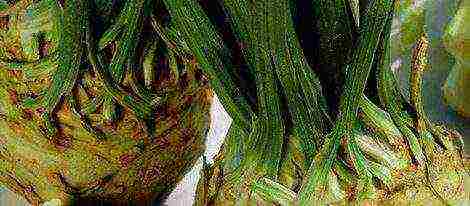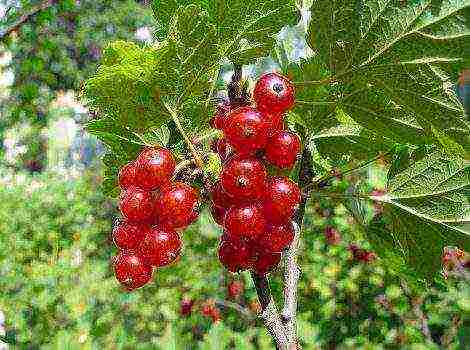Content
- 1 Description of lingonberry
- 2 Popular domestic and foreign varieties of lingonberry
- 3 Agrotechnics for growing lingonberry
- 4 Lingonberry propagation
- 5 Features of growing lingonberries in different regions
- 5.1 Cultivation of lingonberries in Ukraine
- 5.2 Cultivation of lingonberries in central Russia and the Moscow region
- 5.3 All costs will pay off in the second year
- 5.4 Varieties for commercial cultivation
- 5.5 Dutch
- 5.6 German
- 5.7 Polish
- 5.8 Swedish and Finnish
- 5.9 Russian
- 5.10 Where and how to plant
- 5.11 Courting is easy
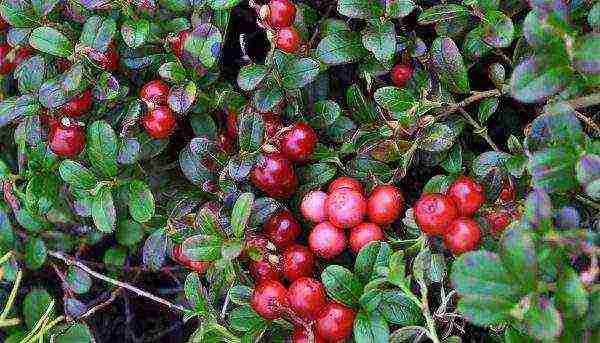
Agrotechnics of garden lingonberries, varieties and basic rules of care will be disclosed in this article.
Lingonberry is a shrub up to 40 cm tall with powerful branched roots. This small shrub is found in coniferous and deciduous forests, as well as forest tundra and swampy areas.
Lingonberry berries are bright red, or, as they said before, crimson, lumber-colored. It is for the color of the fruit that the shrub got its name.
Lingonberry cultivation began recently - about 40 years ago, but by now the culture has already more than 20 varieties. The countries of Scandinavia, Germany and the USA were engaged in the creation of varieties. Some varieties were obtained in Russia, and they are not inferior in quality to foreign ones.
Due to the fact that lingonberry is an evergreen shrub, it is often used as landscaping in the garden. A neat shrub with small, shiny, dark green leaves is often used for garden design or as a hedge.
The plant blooms in late spring - early summer with small white-pink flowers. The berries ripen at the end of summer.
When choosing a planting site, you need to consider the location and characteristics of the soil. The site should be well lit and located away from water bodies or near groundwater. The plant prefers peat soils with a pH of 3.0-5.0 more. Sandy loam soil can be a good alternative, but other types of soil are not suitable for shrubs.
Lingonberry is demanding for watering. Within a week, the plant should receive moisture 2-3 times. Sprinkling is recommended in hot weather. It is necessary to monitor the weeds and weed on time. When loosening the soil, the mulch does not need to be removed.
Lingonberries do not like strong winds, so they can be planted next to conifers to maximize protection from bad weather.
The shrub can be sick with some fungal diseases. The most common of these are exobasidiosis and rust. Diseased plants stop developing and may die. If a disease is detected, lingonberries are treated with fungicides, and the affected areas are removed.
The beginning of fruiting of lingonberries will depend on the quality of the seedlings. Under favorable conditions, lingonberries can bear fruit in the year of planting, but a good harvest should be expected no earlier than the 3rd year.
Conditions for planting lingonberry garden
The conditions for planting garden lingonberries are quite simple and do not require special skills. The selected area must be cleared of weeds and other debris. The soil should be enriched with fertilizers. For lingonberries, nitrogen, potash and phosphorus fertilizers are well suited.
Important: Lingonberry does not react well to chlorine-containing fertilizers, and manure is categorically contraindicated for it.
The planting hole is dug about 30 cm deep. The pit should be about 1.2 meters wide. This is necessary given that the roots of the lingonberry are horizontal and develop well in breadth. To fill the pit, peat is mixed with coarse sand in a ratio of 1: 3. It is important that the planting hole is not in a depression. If the need arises, the garden bed can be raised, especially if the groundwater is close. The bottom of the pit is lined with gravel or rubble. This will help eliminate the problem of stagnant water and saturate the soil with oxygen.
Lingonberries are planted in the spring.
It is best to purchase seedlings in a nursery with a closed root system. This will make it possible to carry out planting throughout the growing season. Plants adapt well to a new place, regardless of their age. Nursery conditions allow to grow a healthy plant with high survival rate.
Lingonberries can be planted both in rows and in ribbon planting. The density of the row depends on the conditions and fertility of the soil.
After planting, the bush must be mulched with peat about 4 cm and watered. Soil moisture should be maintained within 60-70%.
The next year after planting, new bushes grow from the shoots, which gradually close. For 4 years, you can carry out preventive pruning.
back to contents ↑ Care for lingonberries in garden spring
Caring for garden lingonberries in the spring is extremely important, since quite often this plant experiences stress from spring temperature changes. Sudden frosts, which are not rare for many regions even in May, can significantly damage the shrub, which will affect its development and fruiting. To avoid this, you need to cover the lingonberries with foil, and cover them with straw on top. This design will better withstand weather conditions. However, it is not recommended to resort to it for no apparent reason, since often in such conditions the plant may not have enough air.
Tip: Young plants or seedlings after planting are especially in need of additional shelter in spring.
In spring, the plant is fed with mineral fertilizers at the rate of 6 g of potassium sulfate and 10 g of carbamide per 10 liters of water. Further feeding is carried out during fruiting, but it is important to observe the dosage so as not to overfeed the bush.
Throughout the year, caring for the plant consists in abundant watering, feeding and loosening the soil. Regular mulching and loosening will help retain moisture and protect the plant from many diseases. Shrub thinning should be carried out every 5 years. The best time to prune is in spring, before the sap begins to flow.
to the content ↑ Characteristics of lingonberry varieties
Characteristics of lingonberry varieties will help determine the choice of a plant. Breeders have tried to achieve the highest yield of lingonberry and increase its resistance to various diseases. The varieties differ in plant height and fruit characteristics.
The most promising varieties:
- Coral. The variety can be used as a decorative variety. Its second value is in high yield. The shrub is rounded, compact enough, does not exceed 30 cm in height. The crop is about 400 g. It bears fruit twice a year.
- Ruby. A late variety that can withstand frosts down to -30 ° C. Not sensitive to spring frosts down to -3 ° С.
- Red Pearl. Tall variety, bred in Holland. The berries are dark red in color, large - up to 12 mm. It bears fruit twice a year.
- Mazovia. Low-growing variety of Polish selection. The shrub is about 20 cm high. It is often used for ornamental purposes, since the productivity of the shrub is low. Only 40 g of berries can be obtained from one bush.
- Kostroma pink. Low-growing variety up to 15 cm in height. It will decorate the garden well during its flowering, however, it has a low yield.
- Sanna. A variety of Swedish selection. The berries are tasty, large - up to 400 mg.Has a good yield - about 300 g of berries from one bush.
to the content ↑ The chemical composition and benefits of lingonberry
The chemical composition and benefits of lingonberry have long won well-deserved fame around the world.
- Lingonberry berries contain valuable vitamins, acids, tannins, pectins and other substances.
- Lingonberries have a high content of ascorbic acid, polyphenols, chromium, copper and mineral salts. Berries are indicated for consumption:
- With diseases of the gastrointestinal tract
- For the treatment of kidney and bladder
- For colds
- As an antimicrobial, tonic and wound healing agent
- Berries can be used to make jam, syrup, and other dessert dishes and drinks.
- Not only berries are valuable, but also the leaves of the plant, from which a useful broth is made.
It is necessary to use berries with caution for people with stomach diseases with high acidity. People with individual intolerance and allergy to lingonberry need to give it up.
Lingonberry will help maintain health and decorate the garden, especially since growing this plant is not difficult.
There is no doubt that it is very useful to go to the forest for lingonberries. And I breathed in fresh air, and gathered healing berries. But after all, it is not always possible to carve out free time. In order not to be upset in vain when friends drove off into the forest for berries, try planting this unpretentious plant in your garden. Of course, a novice gardener will think about it, is it worth it? But what is really there to think about, of course, it's worth it. After all, lingonberry is unpretentious, almost not affected by diseases and pests and has excellent frost resistance.
Description of lingonberry
There are legends about a small evergreen bush, strewn with bright red berries-beads, pleasing to the eye in the dreary autumn season. One of them tells about a swallow, which, having obtained drops of living water, hurried to bring them to people in order to bestow immortality. But her plans were frustrated by an angry wasp that stung a bird. The swallow spilled invaluable moisture on the ground, and it fell on the cedar, pine and lingonberries that grew under them. Since that moment, these plants have become the embodiment of eternal life, because they do not lose their green outfit either in winter or in summer.
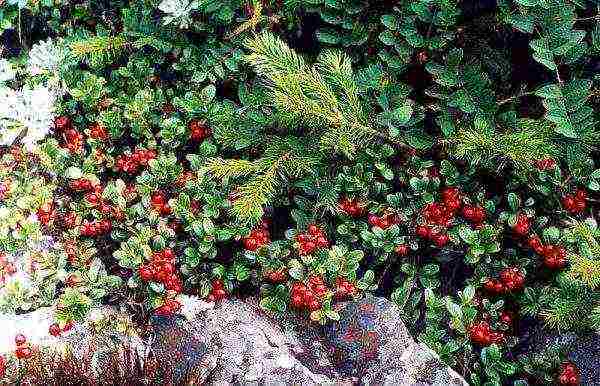
Lingonberry, which does not lose its green leaves all year round, has become the personification of eternal life
Lingonberry is a resident of harsh regions. Its habitats extend along the tundra zone, mixed, coniferous and deciduous forests, peat bogs, it is found on the treeless peaks of the Siberian heights and in alpine meadows.
Lingonberry shrub is tiny, its raised branchy shoots grow from 5 to 25 cm. The rhizome is thin, horizontally located, creeping. Leaves are arranged alternately, often. Their length is from 0.5 to 3 cm, width is only 1.5 cm. The surface is leathery, dark green and shiny above, matte and lighter below. The shape of the leaf plate is obovate or elliptical, the edges are solid, curved. A feature of the plant is the club-shaped formations located on the underside of the leaf that can absorb moisture.
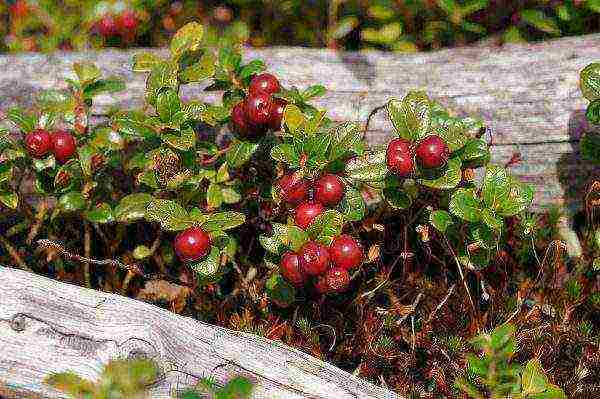
Lingonberry - miniature plant
Lingonberry is a vivid example of the symbiosis of a plant and a fungus. Filamentous mycelium entwines the roots of the berry. The fungus draws nutrients from the soil and transfers them to lingonberries. Therefore, white plaque from the roots of the plant does not need to be removed.
Flowering occurs in May - June. During this period, a delicate aroma is felt over the lingonberry meadow. 10 or 20 flowers, the corollas of which are painted in porcelain white or pale pink, sit on short pedicels. The whole bunch is collected in a drooping brush. The bell-like flowers look very beautiful against the backdrop of shiny greenery.
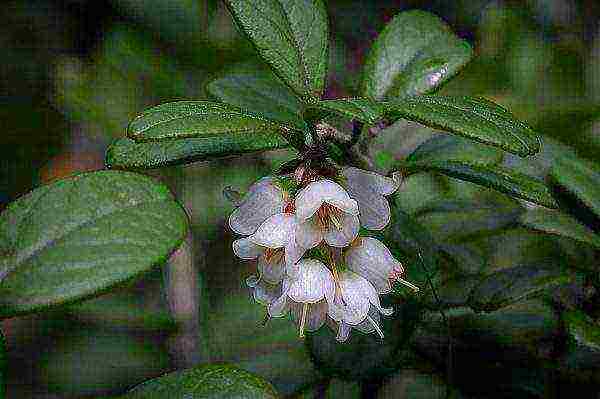
Small, porcelain white lingonberry flowers are collected in bunchy brushes
Lingonberry fruits are shaped like a ball up to 8 mm in diameter. Ripe berries are covered with a shiny red skin, and at the beginning of ripening they are greenish-white. The pulp contains a large number of red-brown, very small seeds.Lingonberries taste sweet and sour, with a slight bitterness, juicy.
Having survived the first frosts, lingonberries become soft and watery. They are already unsuitable for transportation in this form. Under the snow, they can sag on branches until spring, but with the onset of heat, they crumble at the slightest touch.
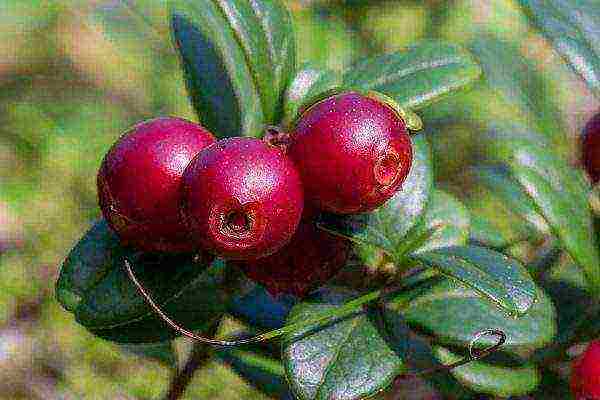
Lingonberry fruits resemble a ball in shape
Lingonberry has been used since ancient times as a medicine. Leaves and berries are used as raw materials. Lingonberry is very popular in the treatment of kidneys as a diuretic, helps in the fight against gout, rheumatism, and lowers blood sugar levels. Lingonberry is also used in cosmetology. A decoction of the leaves helps get rid of dandruff, helps restore skin tone, strengthens it and restores elasticity.
The cultivation of the plant was first started in the 18th century. But it wasn't until 1960 in the United States and Europe that truly mass cultivation was undertaken on an industrial scale. And in Russia, the first plantations appeared in the 80s. The only pity is that on garden plots, a useful berry is a very rare guest. But the breeders have done painstaking work to create new varieties of lingonberry, which, unlike the wild-growing ancestor, have large berries with high taste and bear fruit more productively.
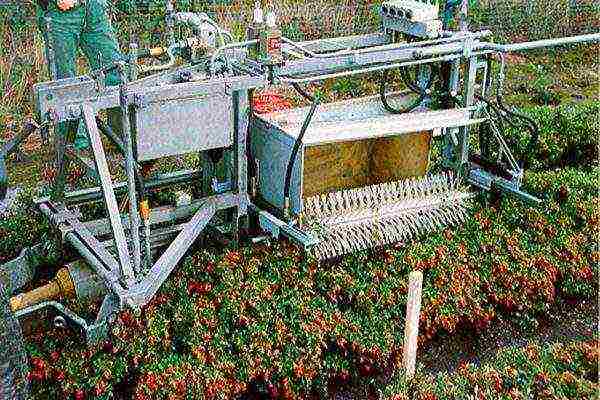
In the USA and Europe, lingonberries have been grown on an industrial scale since 1960.
Popular domestic and foreign varieties of lingonberry
Garden lingonberry differs from the wild-growing mass of positive characteristics, one of which is remontability - the ability to bloom and bear fruit repeatedly or repeatedly during one growing season. In addition, the size and, accordingly, the mass of the berry in a cultivated plant is much larger than that of a forest dweller. And if we take the yield indicator, then cultivated plants from 1 hundred square meters give 20, and sometimes 30 times more berries than ordinary ones.
Table: domestic varieties of lingonberry
Photo gallery: domestic varieties of lingonberry
Table: foreign varieties of lingonberry
Photo gallery: foreign varieties of lingonberry
Agrotechnics for growing lingonberries
Growing lingonberries at home is not at all difficult. You just need to adhere to certain rules.
Landing
If you decide to plant lingonberries on your site, you should consider the following nuances:
- for planting, use young - one- or two-year - plants;
- lingonberry does not like highly fertilized soils;
- only loose and acidic soils with a pH of 3–4.5 have favorable conditions for plant growth and development;
- it is advisable to prepare the soil on your own, be sure to include in its composition high-moor peat, coarse sand, coniferous litter and pine bark;
- the land in which the lingonberry grows must be acidified periodically;
- the landing site should be flat, well lit and slightly blown by the wind, especially after rain or watering, so that excessive evaporation does not provoke fungal diseases. The ideal option would be to place lingonberries next to a pine or juniper hedge. Such natural protection from strong winds will contribute to the active work of pollinating insects;
- the water table must pass 60 cm below the surface.
Landing scheme:
- the distance between the bushes is 25–30 cm;
- row spacing - up to 40 cm;
- planting depth - 10-15 cm.
Video: planting lingonberries and blueberries
Watering, loosening and mulching
First you need to know that lingonberries have a superficial root system, which dries very quickly in loose soil. Therefore, it is necessary to maintain soil moisture at a very high level - at least 70%. This is achieved by watering at least once a week. In a particularly hot period, water should be done more often: up to 2-3 times in 7 days. But at the same time, frequent waterlogging or flooding of lingonberry plantings can stop the access of oxygen to the roots, which will not slow down the effect on the health of the plant.
During the ripening of the harvest of the second wave, flower buds of the future harvest are laid on remontant varieties. And it is during this period that the lingonberry needs watering most of all.
The best method of moistening for lingonberries is sprinkling, but provided that the area is well ventilated. It should be carried out only early in the morning or in the evening, so that wet leaves do not suffer from the sun. In addition to sprinkling, you can use drip irrigation. Water consumption rate per 1 m2 - no more than 10 liters.

If the area where the lingonberry grows is well ventilated, then the plant will like sprinkling.
Planting needs frequent, but careful loosening to get rid of weeds. But digging can not be carried out. Also, be sure to use mulch to help retain enough moisture. Use coarse sand or fine gravel as mulch on peaty soils. For sandy ones, the best choice is pine sawdust and needles, peat.
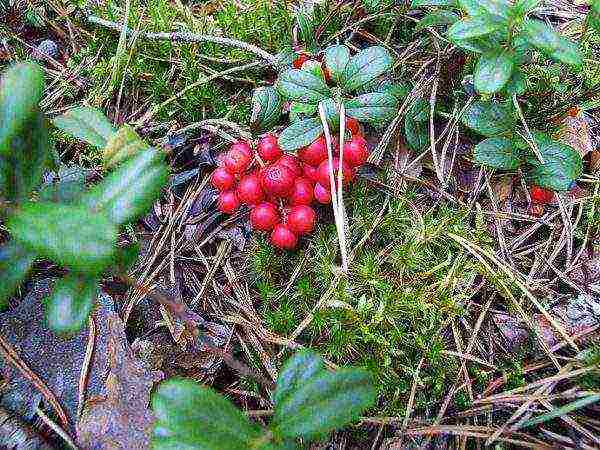
Lingonberry bushes must be mulched
Feeding lingonberry
As mentioned, lingonberry does not like rich soils. Therefore, when fertilizing the plant, do not get carried away. The rule here is that it is better to underfeed than overfeed. Overloading with nutrients can lead to reduced yield, shedding of leaves and stunted growth.
Everyone's favorite organic matter in the form of manure or bird droppings is not suitable for lingonberries. It contains a large amount of nitrogen, which can burn off sensitive roots. In addition, organic matter leaches the soil, which leads to chlorosis, and then to the death of the plant. Potassium chloride is also contraindicated.
Feeding lingonberries should be done no earlier than 3 years after planting, when the berry begins to bear fruit. When choosing fertilizers, give preference to mineral formulations. Choose urea, ammonium nitrate, or ammonium sulfate for nitrogen replenishment. Also, you can not do without potassium sulfate and superphosphate. Plants growing on peat soils require manganese, boron, zinc and copper.
Mineral fertilizers are applied only in liquid form to pre-moistened plantings.
Fertilization table
You can use a complex fertilizer instead of the listed fertilizers, for example, Kemira or Kemira Universal.
Experienced gardeners, instead of fertilizers, regularly apply high-moor peat, distributing it over the soil surface in plantings.
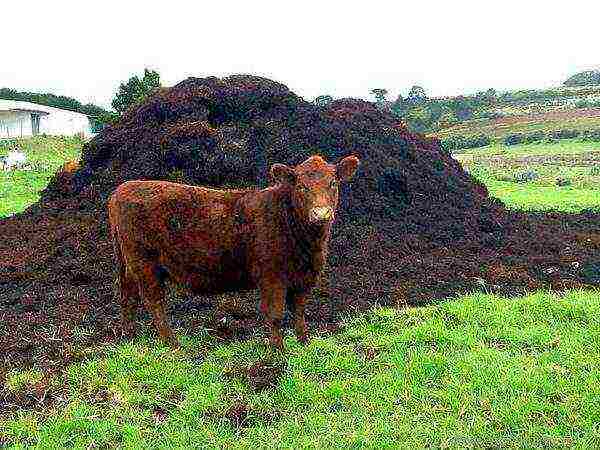
Unfortunately, organic fertilizers are not suitable for lingonberries.
Treatment of lingonberries from diseases and pests
Lingonberry has strong immunity and is resistant to many types of diseases and pests. But with excessive humidity, combined with an elevated air temperature, fungal infections are possible.
- Exobasidiosis. The disease affects shoots, leaves and flowers. In addition to deformation of the leaves, a symptom is a change in their color. The leaf plate becomes pink, a whitish coating of fungal spores appears on it. Bordeaux liquid is used to stop the spread of the disease. Spraying is carried out 3-4 times at weekly intervals. Affected plants will have to be cut and burned.
- Sclerotonia. Fruits are primarily affected. They shrink and mummify. The disease is fought with the help of Bordeaux liquid in the spring, before the leaves bloom, and in the fall, after they fall. 2-3 treatments are carried out. You can use a 0.2% Zuparen solution - 3 sprays with an interval of a week before flowering and the same after harvest. Pick up and destroy the fallen diseased berries.
- Rust. The leaves are covered with dark orange spots. To cope with the disease, 2-3 treatments with Bordeaux liquid are carried out before the leaves bloom and after they fall. Collect and burn all fallen diseased leaves.
Cases of damage by pests are rare, and there is no noticeable damage to plant growth and harvest. Among insects, leaf-gnawing ones are seen - wolf caterpillars, leaf beetles, leafworms. As a rule, at the beginning of the discovery, they are collected by hand.Aphids and scale insects can also attack lingonberries. They are fought with insecticides, in accordance with the instructions and only if absolutely necessary.
Photo gallery: possible diseases and pests
Pruning
This procedure is carried out to rejuvenate the plantings when the lingonberry turns 7-10 years old. By removing most of the old shoots, you maintain the productivity of the bushes. The landings themselves become more durable.
Pruning can be done throughout the growing season. But the best time is still early spring, when the movement of juices has not yet begun. Long shoots are shortened by a third, and the old ones are cut out. In this case, several branches must remain on the bush. And the cuttings obtained after pruning will serve as an excellent planting material and help to expand the plantation.
Lingonberry propagation
It is easy to propagate lingonberries. There are as many as 4 available methods - 3 vegetative and 1 seed, each of which will be considered separately.
Propagation by stem cuttings
- In early spring, before the start of sap flow, or in late autumn, cuttings with a length of at least 5 cm are cut with the help of a secateurs.
- A soil mixture is prepared from 2 parts of peat and 1 part of sand. The mixed soil is poured into containers and moistened.
- Before planting, the cuttings are soaked for several hours in a growth stimulant solution (you can do without this).
- The lower cut of the cuttings is immersed in the substrate, leaving at least 2-3 buds above the surface.
- To maintain high humidity, containers with cuttings are covered with a bag, creating a greenhouse microclimate inside with an air temperature of + 25 ° C.
- The plantings are periodically ventilated and sprayed with water.
- During the growing season, cuttings acquire a root system. The next year they are safely relocated to a permanent place.
Video: how to properly cut lingonberries
Propagation by root segments
The procedure is carried out only if the rhizome area has growth buds or shoots. This lingonberry breeding method is suitable for late April or early May.
- In order for rooting to be successful, a bed is prepared, which is filled with a substrate of sand and peat in proportions of 1: 3 or 1: 2.
- Ten-centimeter depressions are made in the substrate and the surface is moistened.
- Pieces of rhizome are planted, covered with soil and watered again.
- Above the garden bed, wire arcs must be installed and the plantings are covered with a covering material.
- Water for a month, preventing the substrate from drying out. After rooting, the shelter can be removed, but watering must be done regularly. Young plants, which will get stronger by the end of the growing season, are left to winter in the garden.
- Lingonberries grown from root sections will be ready for transplantation to a permanent place in a year or two.
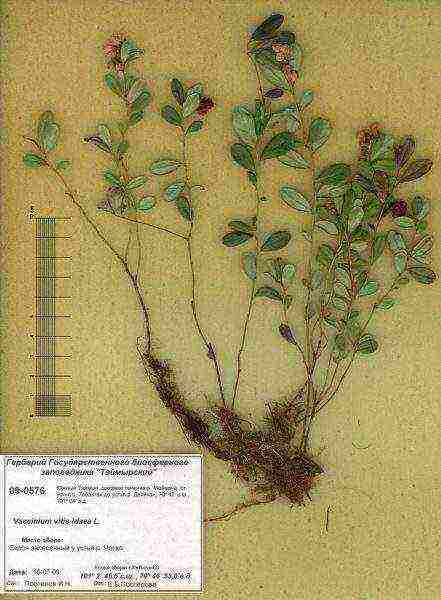
Rhizome with shoots can be divided into parts
Reproduction by partial, or daughter bushes
Young plants are formed from the underground rhizome shoots - stolons - formed in lingonberries. They are linked to the parent plant by the rhizome and are called partial shrubs. For the purpose of reproduction, only bushes are used that have their own root system. Reproduction in this way is possible both in spring and autumn. To do this, young and well-formed bushes are dug up and separated from the mother plant.
- You can plant lingonberry bushes both on a prepared separate bed for growing, and in separate containers.
- Plants grown in containers are ready for transplanting into open ground in a year.
- It is best to plant the bushes on the garden bed for further growing in the spring. The plant will have plenty of time to take root by winter.
- The bushes planted in the fall should be well mulched with peat, spruce branches, or a shelter made of non-woven material should be installed above them.

Partial lingonberry bushes can be planted in separate beds for growing
Seed reproduction
This type of breeding is more suitable for off-grade lingonberries.The process is laborious, but expedient due to the cheapness of the material obtained for the expansion of plantings. Only well-ripened berries are suitable for the selection of seeds. They are kneaded and washed in a little water. The pulp and skin are removed, and the seeds are thrown onto a sieve and then dried.
Before sowing, the seeds must be prepared. This procedure is called stratification. It can be natural - seeds are sown in the garden in the fall. Hardened by winter conditions, seeds germinate in spring. Or you can collect the seeds and store them in wet sand for 4 months at an average temperature of 4 ° C, for example, in the lower compartment of the refrigerator.
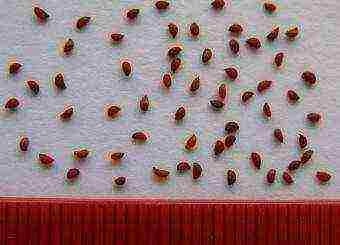
Before sowing, lingonberry seeds must be stratified
The treated seeds show the best germination.
- The seeds are sown in containers filled with a mixture of peat and sand. Since the seeds germinate well in the light, they do not need to be buried.
- To maintain high humidity and an average temperature of 20–25 ° C, the container can be covered with a transparent bag or glass and placed in a bright and warm place. But not in direct sunlight!
- The mini-greenhouse is ventilated and the substrate is moistened.
- After the first shoots appear, the shelter can be removed after 2-3 weeks.
- When 4 adult leaves appear on the seedlings, they can be dived into separate pots or onto a greenhouse bed.
- During the year, the seedlings are regularly watered, after which they are ready to be transplanted to a permanent place.

It is very convenient to germinate seeds in mini greenhouses.
How to grow a garden lingonberry in a pot
Lingonberries, which are compact in size, can be placed at home if desired - on the windowsill or on the balcony. But at the same time, it is worth considering the difficulties that may arise:
- lingonberry has a horizontal and creeping rhizome, which will be cramped in small volumes;
- you will have to strictly control watering, since overdrying and waterlogging of the soil can destroy the plant.
Watering lingonberries is necessary only with rain or water that has settled for several days at room temperature.
For planting you need to prepare:
- low but wide flowerpot. The sizes will depend on the root system of the lingonberry bush. There must be holes at the bottom for excess water to drain into the pan;
- drainage is a must;
- substrate - it is better to prepare it yourself. Regular garden or all-purpose soil will not work. The simplest mixture can be obtained by mixing 3 parts of high peat and 1 part of coarse sand;
- planting material. It can be bought at a garden center or dug up in the forest.
Step by step process:
- Lay a good drainage layer at the bottom of the flowerpot.
- Pour the prepared soil mixture on top.
- Place the bush in the middle of the container and add the rest of the soil to the sides.
- Lightly compact the soil around the perimeter of the flowerpot and water abundantly. It is imperative to remove residual water from the sump.
- You need to keep lingonberries in a bright place, but avoiding drafts. The plant feels very good outdoors. Therefore, if there is a balcony or loggia, you should rearrange the flowerpot there.
Lingonberries in a flowerpot will become a real decoration of a balcony or window sill. Glossy green foliage that does not fall off even in winter will delight the eye all year round. Blooming lingonberry will allow you to admire the miniature flowers, collected in bouquets-tassels. And the ripe coral-red fruits will not only revive the greens, but also help diversify the taste sensations if you add them to the prepared dishes.
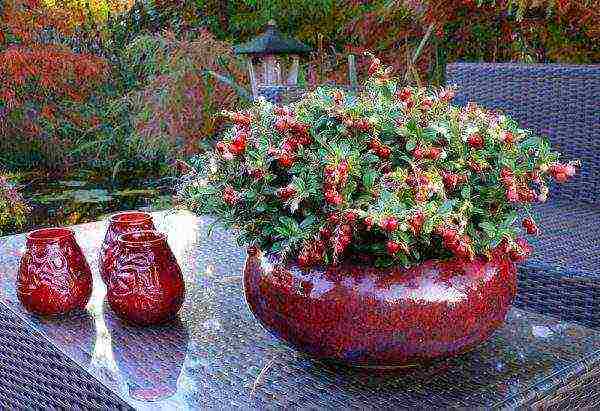
Lingonberries grown in a flowerpot will become a real decoration of a windowsill or balcony
Features of growing lingonberries in different regions
Lingonberry is a fairly plastic plant that tolerates frost and temperature rise well, but only with proper care. The difference between the cultivation of this culture in different regions is that in a hot and medium climate, lingonberry does not require shelter, as it is easily adaptable. In the northern regions for varieties with an early flowering period, spring frosts can become a threat.Therefore, before the onset of stable warm weather, the bushes should be covered with non-woven material.
Cultivation of lingonberries in Ukraine
Lingonberry is not popular in Ukraine. Almost no one grows it. It is possible to meet this plant in nature only in the foothills of the Carpathians, where coniferous forests begin. But varieties adapted to the conditions of the local climate can be cultivated on the plots.
A feature of the cultivation of lingonberries in Ukraine, especially in its southern regions, is frequent watering. If the air humidity is less than 50%, then the plant will have to be watered almost daily. Otherwise, planting and leaving are very similar to the same techniques that are carried out in other regions.
Cultivation of lingonberries in central Russia and the Moscow region
Despite the fact that lingonberries have been grown abroad for a long time on an industrial scale, in Russia they are cultivated only by amateur gardeners, and even then not everywhere.
But in vain. The climate of central Russia and the Moscow region is very suitable for growing this berry. In addition, in the conditions of the Moscow region, varietal plants have enough warmth and daylight hours in order to bear fruit twice. If you follow all the landing and care rules described above, then there will be no problems. For cultivation, try to purchase only zoned varieties.
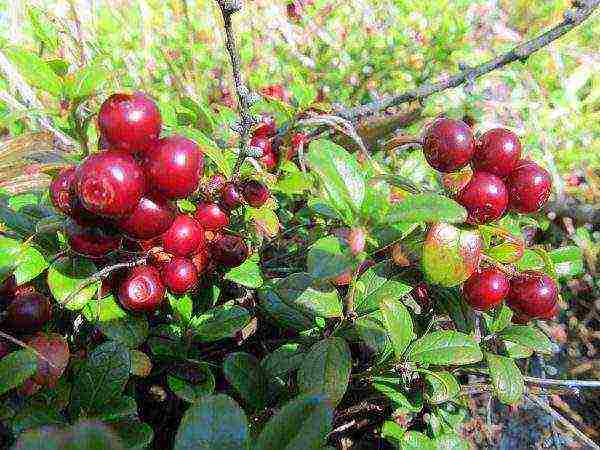
Lingonberry feels great in the climatic zone of central Russia and the Moscow region
Lingonberries can also be cultivated in cooler regions. But in order to get a guaranteed harvest, you will have to stop choosing early varieties.
As soon as a lingonberry meadow appears in your garden, rest assured that guests will not be long in coming. After all, this wonderful plant can be admired all year round. And how charmingly ripe berries peep out from under the fluffy snow cover! In addition to aesthetic pleasure, lingonberry will benefit the body.
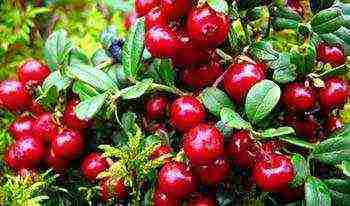
Lingonberries have been grown abroad for a long time on an industrial scale, but for some reason Russian farmers do not like this berry. And in vain - there is no competition in this market segment, and the demand for useful products is always stable and the price for it is high.
Lingonberry production is concentrated mainly in Sweden and Finland, there are separate plantations in Germany and the USA. In Russia, small quantities of varietal lingonberries are grown only by amateur gardeners. Meanwhile, commercial production of this berry can become a very profitable business.
In a little more than 40 years, more than 20 varieties of lingonberry have been registered in the world (3 of them are in Russia), industrial plantations have been laid and even machines have been created to mechanize the processes of caring for plantings and harvesting berries.
All costs will pay off in the second year
The main part of the cost of laying a lingonberry plantation is the cost of seedlings. However, it is very profitable to grow lingonberries. The plantation planted with 3-year-old seedlings begins to yield berries already in the year of planting, and after a year it reaches its design capacity.
Even with a minimum yield of 200 g / bush with a one-line planting in the 2nd year, you can get about 80-100 kg / 1 hundred square meters of berries, the cost of which will be about 24-25 thousand rubles. This allows you to recoup all the costs of its production in 2 years and already make a profit.
The lifespan of a lingonberry plantation without rejuvenating pruning is at least 15 years, and with rejuvenating pruning, carried out once every 10-12 years, at least 50-60 years. During this period, investment of money is required only for harvesting, mulching, feeding and, if necessary, treatment for diseases, while the income from the sale of berries significantly exceeds these costs. Since the primary costs of laying a lingonberry plantation are significant, you can start a business with a few hundred square meters, and then, earning money on the sale of berries, gradually increase the planting area.
Varieties for commercial cultivation
Industrial plantings of lingonberries are laid with planting material that is homogeneous in biological characteristics and yield, i.e.varietal seedlings - if you plant bushes dug out in the forest or sow seeds collected from wild bushes, there can be no question of a normal harvest.
Dutch
Of all the varieties of lingonberry, the most popular today Dutch variety Coral (Koralle).
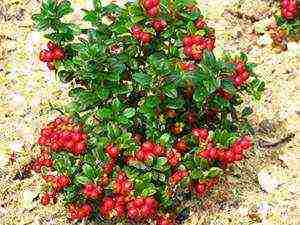
Registered in 1969, it is still the highest-yielding species - 0.2-0.4 kg / bush and more. Bushes more than 30 cm high and wide have long erect shoots, oval leaves. The berries are medium (0.8-0.9 cm in diameter), light red, sweet and sour with a slight bitterness. Forms two harvests per season: late July - early August and late September - early October.
Another Dutch variety, registered in 1981, is no less famous - Red Pearl.

Tall and sprawling, densely branched plants reach a height of 20-30 cm. The leaves are large, round, dark green. The berries are large (7-12 mm), round, dark red, good taste, sweet and sour with a slight bitterness. Able to form two crops per season.
German
The variety is quite popular in Germany Ammerland... A shrub with a height and width of 30 cm forms a crop twice a season: in late July - early August and late September - early October. The yield is high - 0.2-0.3 kg / bush and more. The berries are medium (0.9-1.1 cm in diameter), light red, sweet and sour. The aerial part grows well, forming compact, abundantly fruiting, spherical bushes, similar to the Coral variety.
Low (up to 20 cm) bushes in the variety Erntekrne, registered in 1978.
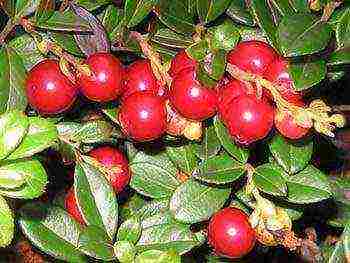
The berries are somewhat larger (0.9-1.1 cm in diameter) than the Coral variety, dark red, with very good taste (sour-sweet with a slight bitterness), juicy. Forms two harvests annually, but summer fruiting is unstable. The yield is about 1.5 times lower than that of the Coral variety.
The largest-fruited variety (berry diameter - 1.2-1.4 cm) - Erntesegen.
Tall bushes (up to 40 cm), long flexible shoots, large, elongated leaves. The berries are light red, with very good taste - sour-sweet, with a slight bitterness. True, the yield is 2 times lower than that of the Coral variety.
Polish
Low-growing bushes (up to 15 cm) are typical for varieties Masovia, which forms many rhizomes and very quickly covers the soil with a solid carpet.

The berries are dark red, medium, with good taste, sweet and sour. Ripen at the end of August. The yield is good, but lower than that of the Coral variety.
Differs in good yield Runo Bielawskie variety, bred in 1996. Bushes are compact, 25-30 cm high, dense. The leaves are oval, dark green. The berries are oval, the skin is thin, tender, dark red. Ripens in early September.
Swedish and Finnish
Strong, tall (up to 25 cm), weakly branched bushes with large leaves in Linnea varietiesregistered in 1997

An early ripe variety, ripens from mid-August. It is capable of weak secondary flowering. Harvest at 3 years of age - 150 g / bush. Partitioning (overgrowth) is weak. Berries are medium to large, bright red, sweet and sour, with a slight bitterness.
Dense and compact bushes in the form of a dense ball 15-20 cm high near Ida varieties, registered in 1997. Leaves are large, partialization is weak. The fruits are large (1 cm in diameter), bright red, sweet and sour, ripen from mid to late August. The variety is capable of secondary flowering and fruiting. Productivity at 3 years of age is on average -140 g / bush.
Forms a continuous carpet quickly variety Sanna (Sanpa)characterized by intensive partitioning.
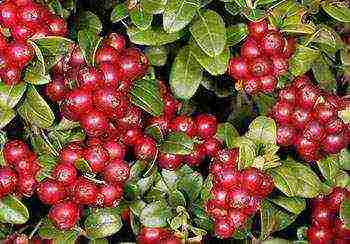
Registered in 1988. Erect bushes, 15-25 cm high. Leaves are elliptical or obovate. Fruits are red, round, weighing 0.4 g, sweet-sour, ripen in mid-August. The yield of adult bushes is 300-400 g / bush.
Low-growing bushes 10-20 cm high Sussi varieties, registered in 1988. The berries are round, dark red, large, weighing 0.4 g, sweet and sour.The crop ripens in the 3rd decade of August. The yield is slightly lower than that of the Sanna variety.
Russian
Evenly branched bushes 15 cm high varieties Kostroma pink, registered in 1995, a mid-season self-fertile variety, ripens in the Kostroma region on August 15-20. Fruits are round, about 1 cm in diameter, pink in color, with a sweet and sour taste. Average weight - 0.34 g. Productivity - 0.76-2.68 kg / m2.
Very dense, densely branched bushes 15-18 cm high in the Kostromichka variety, registered in 1995. An early maturing variety in the Kostroma region ripens on August 10-15. Fruits are round, 7-8 mm in diameter, dark red, sweet acid. Average weight - 0.24 g. Productivity - 0.96-2.48 kg / m2.
Intensive partisation is characterized by grade Rubin, registered in 1995
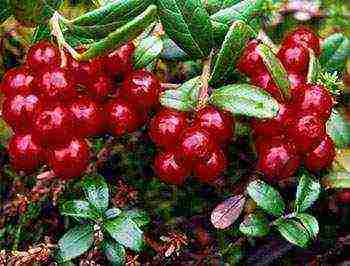
Bushes are medium-sized, 15-20 cm high. Late-ripening self-fruitless variety, ripens in the Kostroma region on August 20-25. The fruits are round, dark red, sweet and sour. Average weight -0.22 g. Productivity - 0.94-2.88 kg / m2.
All of these varieties can be successfully grown not only in central Russia, but also much further north. Indeed, firstly, lingonberry is winter-hardy and without shelter can withstand frosts down to -30 ° C; secondly, the height of the bushes does not exceed 20-45 cm, due to which they are well covered with snow and do not suffer even in frosts below -30 ° C.
Where and how to plant
It is necessary that the site for laying a lingonberry plantation meets a number of requirements. The site should be well lit, protected from the wind, so that it is comfortable for pollinating insects, and in winter the snow does not blow off the plantation. The soil should be loose, water and air permeable and very acidic (pH 3.5-5.5). High-moor peat bogs, sands and sandy loam are suitable. On other types of soils, before planting, you will have to improve their structure.
On sandy, sandy loam and clay soils, lingonberries can be grown in rows enriched with peat. On the site, furrows are plowed with a depth and width of 10 cm and filled with acidic (pH 3-5) high-moor peat. To fill 100 linear meters. m of furrow, 1 m2 of peat is required.
More often, a one-line planting scheme is used, when the distance between the lines (rows) is 0.75-1.0 m, and between plants in a row is 25-30 cm. In this case, an average of 400 seedlings / weaving is placed. This scheme is most convenient for mechanizing planting, plantation maintenance and berry harvesting. For this planting option, the most suitable varieties are characterized by weak partialization: Coral, Amerland, Red Pearl.
In this case, the plantings do not thicken, and the farmer does not need to spend time and money cleaning the row spacings.
Expert Council
Do not use manure or poultry droppings for lingonberries! These fertilizers alkalize the soil (which is unfavorable for the crop) and contain a large amount of nitrogen; because of which you can simply burn the plants.
Courting is easy
Lingonberries require minimal fertilizing - no more than 250-300 g / hundred square meters of complete mineral fertilizer. It is better to use special fertilizers recommended for heather. Of the most suitable and widely used, we can recommend "Kemiru-Universal", "Kemira-Lux", "Solution".
To protect against weeds, the rows are mulched with sawdust, and the aisles are treated with roundup or weeds are mowed there. Mulching is carried out once every 2-3 years: the width of the mulch layer is 25-30 cm, the thickness is 5-7 cm.
To diseases and pests lingonberries are resistant, so treatments are rarely required. For prevention, you can 2 times a year - in early spring and late autumn, when the plants are at rest, - to process the plantings with Bordeaux liquid.
With commercial cultivation of lingonberries, harvesting is the most laborious. It is carried out manually using special scrapers. Harvested berries do not deteriorate for a long time due to the content of benzoic acid in them, which prevents the development of yeast fungi.
By the way, additional profit can be obtained from the sale of seedlings.
Varietal lingonberries are propagated only vegetatively: rhizomes, partial bushes or stem cuttings. With seed propagation, there is a significant splitting of characters and a complete lack of uniformity. Cuttings are rooted exclusively in the greenhouse, other methods can be used in the open field. Rooted cuttings are grown in the open field in pots or in the beds in the school. Commercial seedlings are obtained, as a rule, after 3 years from the date of cuttings. Well-developed plants (10-12 cm high with 3-4 shoots) are used for planting the plantation, the weaker ones are left in the school for another 1 year.
Lingonberry garden - growing and care
